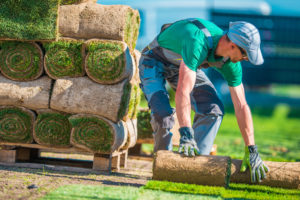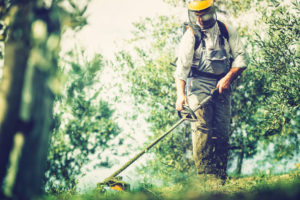Five Safety Tips for New Landscapers

1. Take a Walk Around
Before you head to the tool shed, survey the yard. Especially the first time out after a long winter, there may be surprises awaiting you:
- Remove debris such as fallen branches or the kid’s tricycle.
- Eliminate wasp or bee nests, poison ivy, stickers and thistles.
- Trim low hanging branches to eliminate “low bridges.”
- Fill in holes or ruts and drain slippery, muddy areas.
2. Read the Manual Like You Mean It
Before using a new power tool, read those first 10 pages or so of the operating manual. Those are the ones that discuss why using your hedge trimmer in the shower is not a mark of genius. Even though most of the information appears aimed at those with less common sense than a gnat, those general safety instructions are worth poring over at least once in your life.
Also, read the remainder of the manual to understand how the tool works, its safety features and maintenance schedule. Do not attempt any repairs while the tool is connected to its power source or running. Do not modify the tool in any way that compromises its safety features.
3. Protect Yourself and Others from Injury

Other ways to prevent injury are equally important:
- Wear long pants and long sleeve shirts
- Avoid excessively loose clothing or jewelry
- Always wear gloves
- Use safety glasses and ear protection
- Use a filter mask and disposable gloves if you are handling pesticides or herbicides
4. Do Not Overdo It
If landscaping and gardening are not your everyday tasks, then digging, swinging, squeezing and wrestling with hand and power tools is bound to help you discover some unused muscles. Be aware of what your body is telling you when it sends you a twinge of pain:
- Taking frequent breaks is smart, not lazy. You actually accomplish more if you take a 5-minute break every half-hour than if you plow through the entire job all in one go.
- If you feel pain while performing a task, try changing posture or using the tool from a different angle.
- Lifting heavy objects such as bags of dirt, large pots or stones can result in pulled muscles. Ask for help moving heavy objects, and use your legs rather than your back when lifting.
Equally important to avoiding injury from heavy work or repetitive movement, is making sure you stay well hydrated and that you adjust your clothing to match the weather. Do not risk hypothermia or sunstroke due to extremes of cold or heat.
5. Turn the Chore into a Pleasure
Landscaping can be hazardous to your health unless you apply common sense safety precautions and do not try to turn it into a Bataan death march. In fact, many people find that taking care of their own garden and yard relieves the stress of the workweek You may find that it brings an enjoyable sense of accomplishment into your life too!
Ready to get your hands dirty? Stop by our showroom and pick up everything you need for the weekend’s landscaping project.